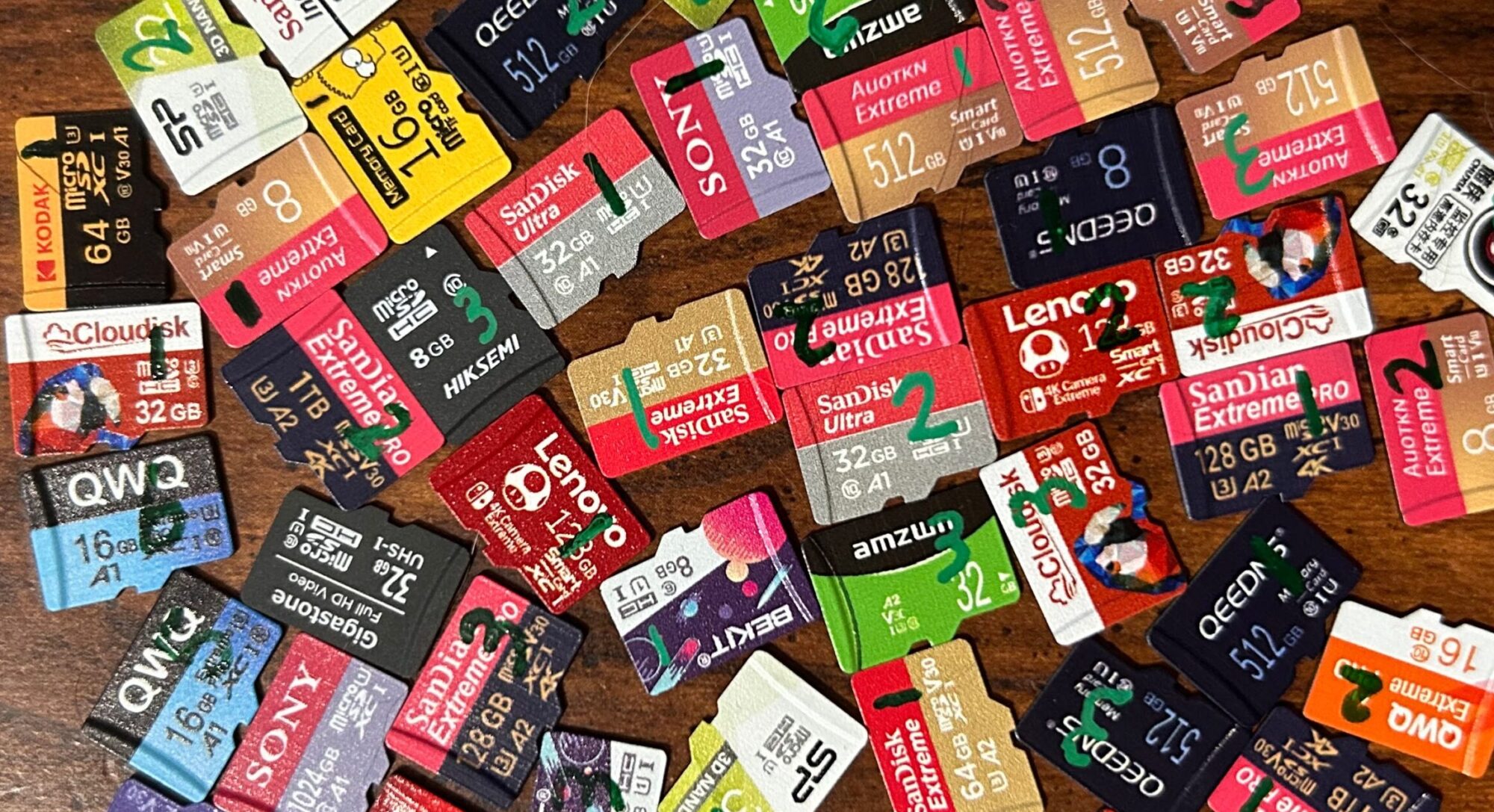Gigastone is a brand that seems to show up frequently in Amazon searches — and there’s at least some evidence that they’re trying to work their way into the American retail market as well.
These cards fail the criteria I set out for determining what’s considered a name-brand card, primarily for one reason: the contents of these cards’ CID registers indicate that the vendor was trying to mask their true origin. Specifically, the manufacturer ID was set to hex 00, the OEM ID was set to hex 3432 (or ASCII 42), and the product name was set to hex 3030303030 (or ASCII 00000). However, they don’t meet the criteria for being a knockoff card, so I’ll throw them in the off-brand bin.
I tried to start this project back in 2021, but never fully got it off the ground; this was one of three cards that I purchased for that failed attempt. Sample #1 came from this early attempt. I did not do performance testing or pull register data on these early cards — this is why this information does not show up here. Capacity was determined using f3probe, and endurance testing was performed using stressdisk. I don’t recall what the card’s physical capacity was, only that it matched the card’s logical capacity and thus was not fake flash. The logs from stressdisk would suggest that the capacity was somewhere between 29.2GB and 30.6GB1. This would suggest a skimp factor between 5% and 9%; however, keep in mind that stressdisk performs stress testing by writing files to the filesystem — and thus the filesystem overhead needs to be taken into account when determining the card’s true skimp. Just before failure, stressdisk reported read speeds of 80.66MB/sec and write speeds of 23.74MB/sec.
I eventually decided that it would be good to get some more samples of this card and run them through the same suite of tests as my other cards. Fortunately, they are still in plentiful supply on Amazon.
Upon examining the CID data for these newer samples, I was honestly surprised to see the manufacturer ID zeroed out — as this is typical of fake flash or low-quality flash, where the seller doesn’t want the card to be traced back to a particular manufacturer. This is not a particularly good sign, especially for a card that has made an appearance in at least one major retailer in the US market. There are some clues I could look at to try to determine who made them — such as the OEM ID, the product name, and the etchings on the back of the card — but none of them seem to yield conclusive results.
Performance results were disappointing. Sequential read scores were a little bit above average, but all other scores were at least a little below average. These cards bear the Class 10 and U1 marks, and performance was good enough to qualify for both of those marks. (I guess…yay for setting the bar low?)
On the endurance testing front:
- Sample #1 did not show any errors until round 1,786, when it stopped responding to commands.
- Sample #2’s first error was a four-sector wide address decoding error during round 382. It survived another 3,700 or so read/write cycles. Then, one day, the USB hub it was connected to needed to be reset; after the reset, this card refused to respond to commands. Up to that point, only about 0.2% of the card’s sectors had been flagged as “bad”.
- Sample #3’s first error was a series of bit flip errors, affecting 74 sectors, during round 1,786. It survived about another 3,400 read/write cycles before it stopped responding to commands altogether. Up to that point, about 3% of the card’s sectors had been flagged as “bad”.
- Sample #4’s first error was a series of bit flips, affecting 10 sectors, during round 2,096. It continued to do just fine up until the end of round 4,545 — at that point, I (gracefully) shut down all of my testing rigs so that I could do some electrical work on my house. When I turned the power back on, this card would not respond to commands. Up to that point, less than 0.1% of the card’s sectors had been flagged as “bad”.
- Sample #5’s first error was a series of bit flips, affecting two contiguous sectors, during round 1,843. It another 3,800 read/write cycles before it stopped responding to commands entirely. Up to that point, about 3.2% of the card’s sectors had been flagged as “bad”.
- Sample #6’s first error was a series of bit flips, affecting four contiguous sectors, during round 1,837. It continued to accumulate errors progressively until round 5,108, when it stopped responding to commands altogether. Up to that point, about 1.8% of the card’s sectors had been flagged as “bad”.
So overall, what do I think of these cards? Meh. A lot of metrics were below average, and they didn’t do very well on endurance tests — in particular, it was a little disturbing to see that not a single one made it past 6 months. I think my advice would be “don’t buy these — there are better options out there for less money”.
1I don’t know if stressdisk was using binary MB/GB (e.g., 1MB = 1,048,576 bytes and 1GB = 1,073,741,824 bytes) or linear MB/GB (e.g., 1MB = 1,000,000 bytes and 1GB = 1,000,000,000 bytes). It does make a difference — I use binary MB/GB for performance test results; if stressdisk was using linear MB/GB, then those 80.66MB/sec would equate to 75.12MB/sec had it been tested with my program.
September 26, 2025

